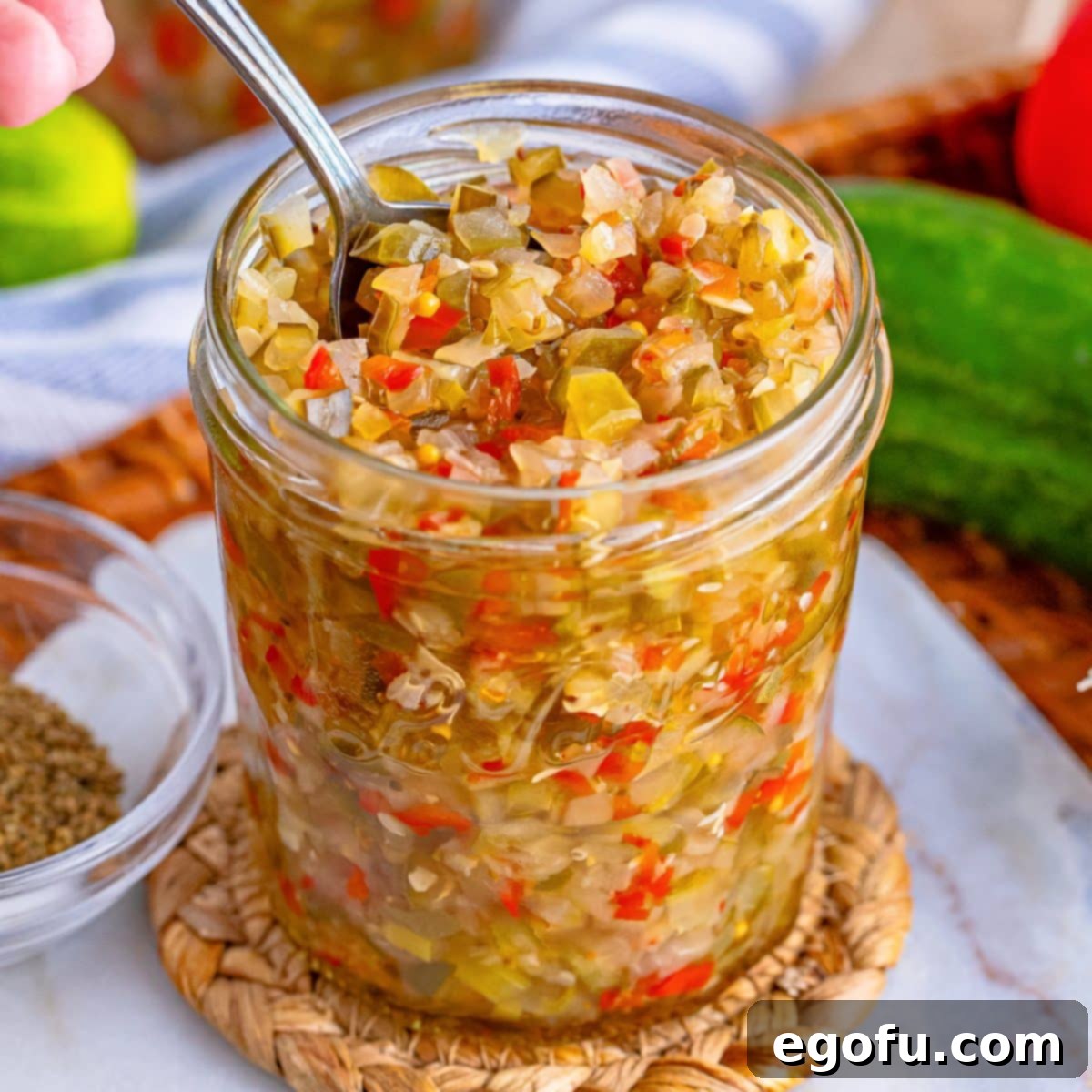Homemade Sweet Pickle Relish: Your Ultimate Guide to a Tangy-Sweet Condiment
Ditch the store-bought jars and embark on a culinary adventure that promises to elevate your taste buds: crafting your very own Sweet Pickle Relish from scratch! This delightful condiment, with its perfect balance of tangy and sweet notes, is surprisingly simple to make and yields a vibrant, flavorful addition to countless dishes. Once you experience the fresh, crisp taste of homemade relish, you may never look back at the supermarket aisle again. It’s an incredibly versatile staple, destined to become a favorite in your kitchen.
The Allure of Homemade Sweet Pickle Relish
Sweet Pickle Relish is more than just a topping; it’s a celebration of finely chopped, perfectly seasoned vegetables brought to life with a sweet and tangy brine. While pickles themselves are simply cucumbers preserved in a flavorful solution, relish takes this concept a step further by finely dicing the cucumbers and combining them with other vibrant ingredients like bell peppers and onions. This creates a condiment with an incredibly complex flavor profile and a delightful texture that complements a wide array of foods. The subtle sweetness beautifully offsets the sharp tang of vinegar, resulting in an irresistible burst of flavor with every spoonful. This homemade version surpasses its commercial counterparts in freshness, quality, and the ability to customize its taste to your exact preference.
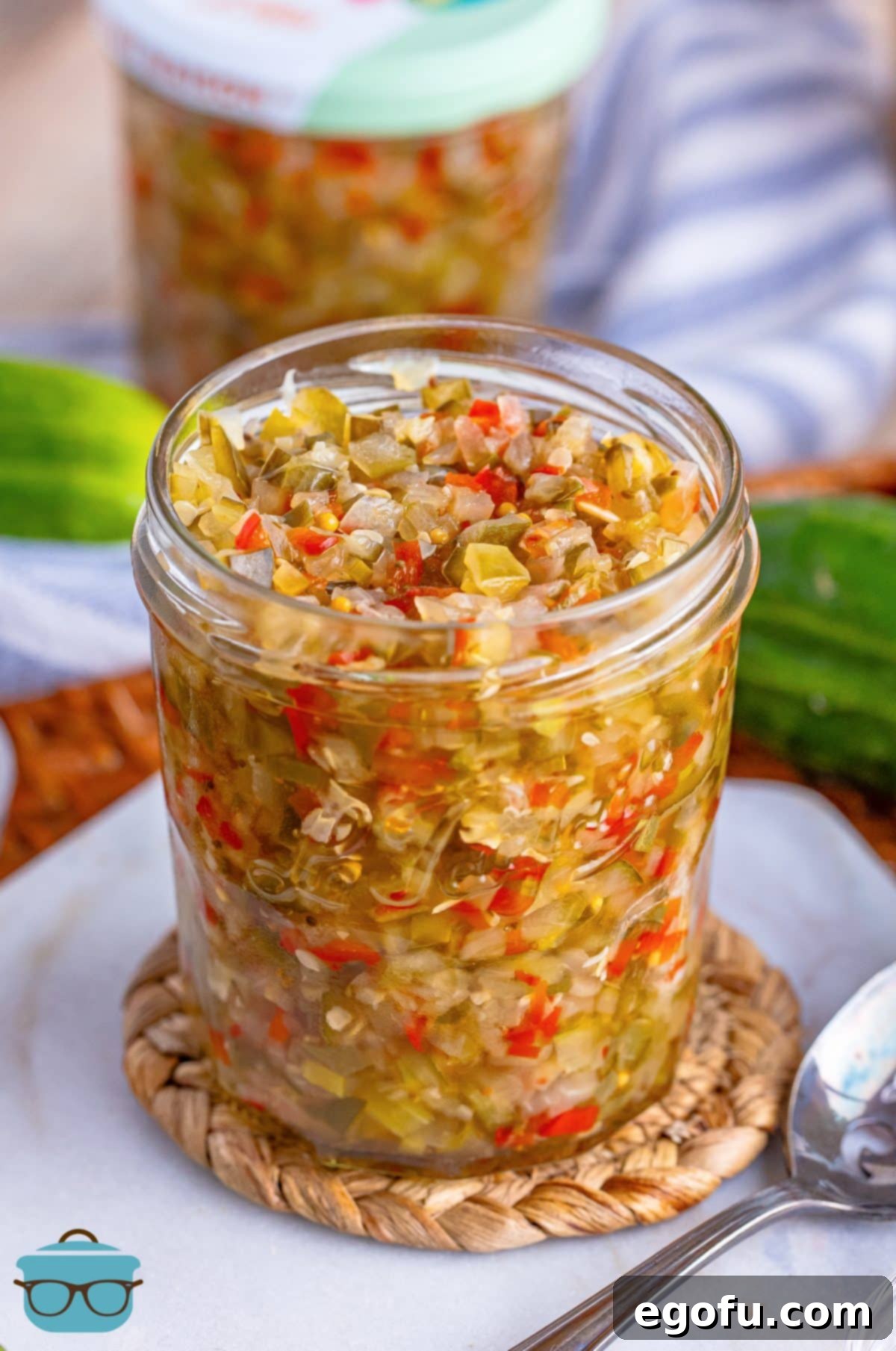
Why DIY Sweet Pickle Relish? Unbeatable Flavor & Freshness
Making your own homemade sweet pickle relish offers several compelling advantages over store-bought varieties. First and foremost is the superior flavor. Commercial relishes often contain artificial preservatives, colors, and an unbalanced sugar-to-vinegar ratio. When you make it yourself, you control every ingredient, ensuring only the freshest vegetables and natural spices are used. This results in a relish that tastes brighter, crisper, and more authentically delicious. You also gain the ability to customize the sweetness level, adjust the tanginess, or even introduce a hint of spice, tailoring it perfectly to your family’s palate. Moreover, it’s a rewarding process that connects you to traditional cooking methods and provides a sense of accomplishment. The effort is minimal, often requiring about an hour of active prep and cook time, with the longest part being the overnight chilling period that allows the flavors to truly meld and deepen. This small investment of time yields a profoundly satisfying condiment that will impress everyone.
Beyond Hot Dogs: Versatile Uses for Your Sweet Pickle Relish
While sweet pickle relish is famously associated with hot dogs and hamburgers, its culinary applications extend far beyond the grill. Its vibrant flavor and pleasing texture make it an indispensable ingredient in a myriad of dishes, transforming everyday meals into something special. Explore these exciting ways to incorporate your homemade relish:
- Classic American Fare: Instantly upgrade your deviled eggs, add zing to egg salad, or lend a tangy sweetness to savory ham salad, tuna salad, and chicken salad sandwiches.
- Sauces and Dressings: It’s a foundational component for creamy tartar sauce, perfect for fish and chips, and provides the signature flavor in Thousand Island Dressing. You can also mix it into barbecue sauces or cocktail sauce for an unexpected twist.
- Grilling and BBQ: Serve it alongside grilled sausages, bratwurst, or as a topping for pulled pork sandwiches. Its acidity cuts through rich meats beautifully.
- Dips and Spreads: Stir it into cream cheese for a savory bagel spread, blend it into a yogurt-based dip for vegetables, or mix it with mayonnaise for a quick sandwich spread.
- Main Dishes: Incorporate it into meatloaf mixtures, add a spoonful to sloppy joes, or use it as a flavorful topping for chili. Some even enjoy it as a relish for pork chops or roast chicken.
- Salads: Beyond egg and tuna salads, mix it into potato salad, macaroni salad, or even a simple green salad for an extra layer of flavor and crunch.
- Cheese Boards: A small bowl of homemade relish makes a sophisticated addition to any cheese and charcuterie board, pairing wonderfully with sharp cheeses and cured meats.
With such incredible versatility, it’s clear why having a jar of this homemade goodness in your fridge is a game-changer for enhancing your culinary creations.

Mastering the Ingredients: What Goes into the Best Sweet Pickle Relish
The secret to exceptional homemade sweet pickle relish lies in the quality and preparation of its core ingredients. Each component plays a crucial role in achieving the perfect balance of flavor, texture, and aroma. Here’s a detailed look at what you’ll need and why:
- Pickling Cucumbers: These are ideal for relish due to their thinner skins and crisp texture. If pickling cucumbers are hard to find, English or Persian cucumbers are excellent substitutes and typically don’t require peeling. Regular garden cucumbers can also be used, but you might want to peel them if their skins are thick or bitter. For larger varieties, removing the seeds before chopping can prevent a watery relish. The key is to end up with approximately 2 pounds of finely chopped cucumber.
- White Onion and Red Bell Pepper: These aromatic vegetables add depth, a subtle sweetness, and a beautiful color contrast to the relish. White onions provide a sharp, fresh bite that mellows during cooking, while red bell peppers contribute natural sweetness and a vibrant hue. If you have a strong aversion to either, you can certainly omit them without needing to adjust other ingredients. However, their inclusion significantly enhances the overall flavor profile.
- Pickling Salt: Unlike regular table salt, pickling salt is free from anti-caking agents and iodine, which can cloud the pickling liquid or affect the flavor. Kosher salt (ensure it’s pure salt without additives) is an excellent alternative. The salt is essential for drawing out excess moisture from the vegetables, contributing to a crispier relish, and for the initial brining process.
- Cold Water: Used in conjunction with salt, cold water helps draw out additional moisture from the chopped vegetables, ensuring a firm texture and preventing dilution of the final relish brine.
- Apple Cider Vinegar: This is the heart of the relish’s tangy flavor. Apple cider vinegar is preferred for its milder, fruitier acidity compared to the sharper taste of white vinegar, which some find too harsh. It beautifully complements the sweetness and spice, creating a more harmonious blend.
- Granulated Sugar: Providing the “sweet” in sweet pickle relish, granulated sugar balances the vinegar’s acidity. The beauty of homemade relish is that you can adjust the sugar content to your personal preference. For a sweeter relish, you can increase the amount up to 1½ cups without significantly altering the recipe’s integrity.
- Celery Seeds: Do not skip these! Celery seeds impart a distinct, earthy, and slightly bitter flavor that is quintessential to classic relish. They add a layer of complexity and aroma that is irreplaceable.
- Mustard Seeds: Whole mustard seeds are crucial for both flavor and visual appeal. Using mustard powder can result in a cloudy liquid and a less appealing texture. The seeds release their pungent, peppery flavor gradually during cooking and chilling, contributing significantly to the relish’s character.
By understanding the role of each ingredient, you can appreciate the intricate balance that makes this homemade sweet pickle relish so exceptional.

Step-by-Step: Crafting Your Own Sweet Pickle Relish from Scratch
Creating your own homemade sweet pickle relish is a straightforward process that yields incredibly rewarding results. Follow these detailed steps to achieve a perfectly balanced and flavorful condiment:
- Prepare the Vegetables: Begin by finely chopping your pickling cucumbers, white onion, and red bell pepper. The key to a good relish is a consistent, fine chop, as this ensures even flavor distribution and a pleasant texture. Place all the finely chopped vegetables into a large, non-reactive bowl.
- Salt and Soak: Sprinkle the chopped vegetables generously with pickling salt. Then, add enough cold water to fully submerge the vegetables. This brining step is crucial; it helps to draw out excess moisture, ensuring the relish remains crisp and flavorful, and contributes to its preservation. Allow the mixture to sit at room temperature for 1 hour.
- Drain Thoroughly: After the hour of soaking, it’s vital to drain the vegetables very well. Use a fine-mesh sieve or a colander lined with cheesecloth to remove as much liquid as possible. Gently press down on the vegetables with the back of a spoon to squeeze out even more moisture. This step prevents the relish from becoming watery and diluting the vibrant flavors of your brine. Set the drained vegetables aside.
- Prepare the Brine: In a large pot or Dutch oven, combine the apple cider vinegar, granulated sugar, celery seeds, and mustard seeds. Place the pot over medium heat and stir constantly until the sugar completely dissolves. Once dissolved, bring the mixture to a rolling boil.
- Combine and Cook: Add the thoroughly drained vegetables to the boiling brine. Stir everything together well to ensure the vegetables are evenly coated. Return the mixture to a boil, stirring frequently, and continue to boil for 10 minutes. This cooking time allows the flavors to meld and the vegetables to absorb the delicious brine.
- Jar and Cool: Remove the pot from the heat. Using a slotted spoon, transfer the cooked vegetables into clean, sterilized jars. Then, pour the remaining liquid from the pot over the vegetables in the jars, ensuring they are fully submerged.
- Chill for Flavor Development: Allow the jars to sit at room temperature until they are completely cooled. Once cooled, seal them with their lids and place them in the refrigerator overnight. This overnight chill is crucial, as it allows the flavors to fully blend, deepen, and permeate the vegetables, resulting in a perfectly balanced and incredibly delicious sweet pickle relish. Serve chilled for the best experience.
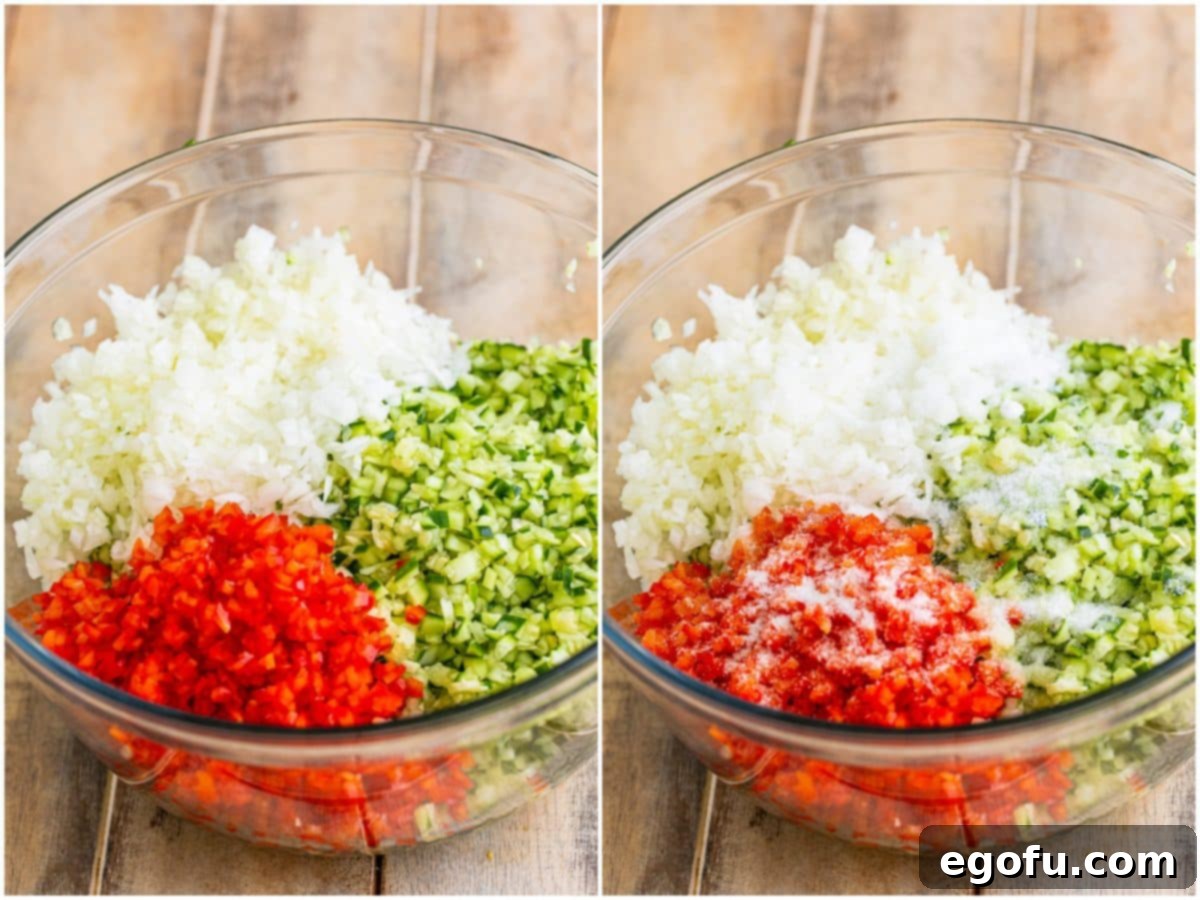

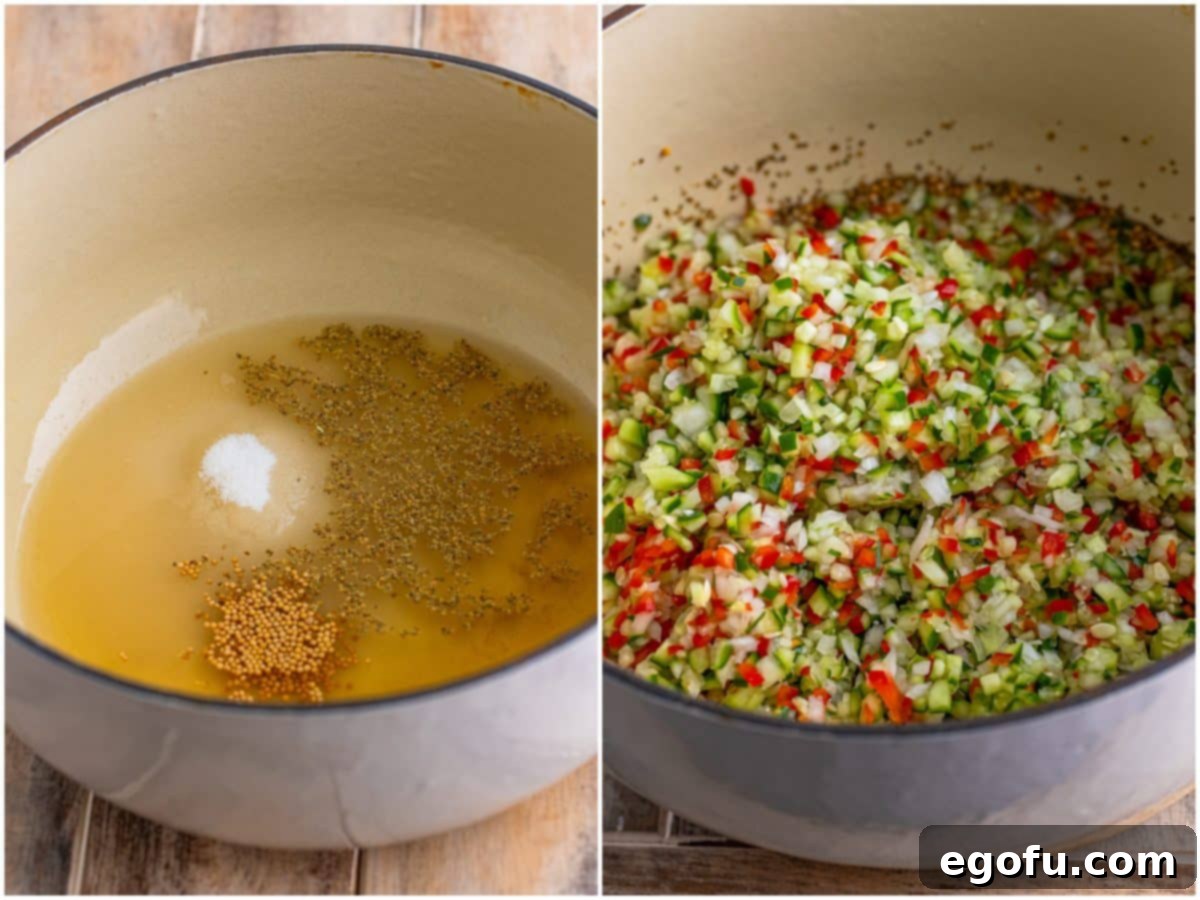
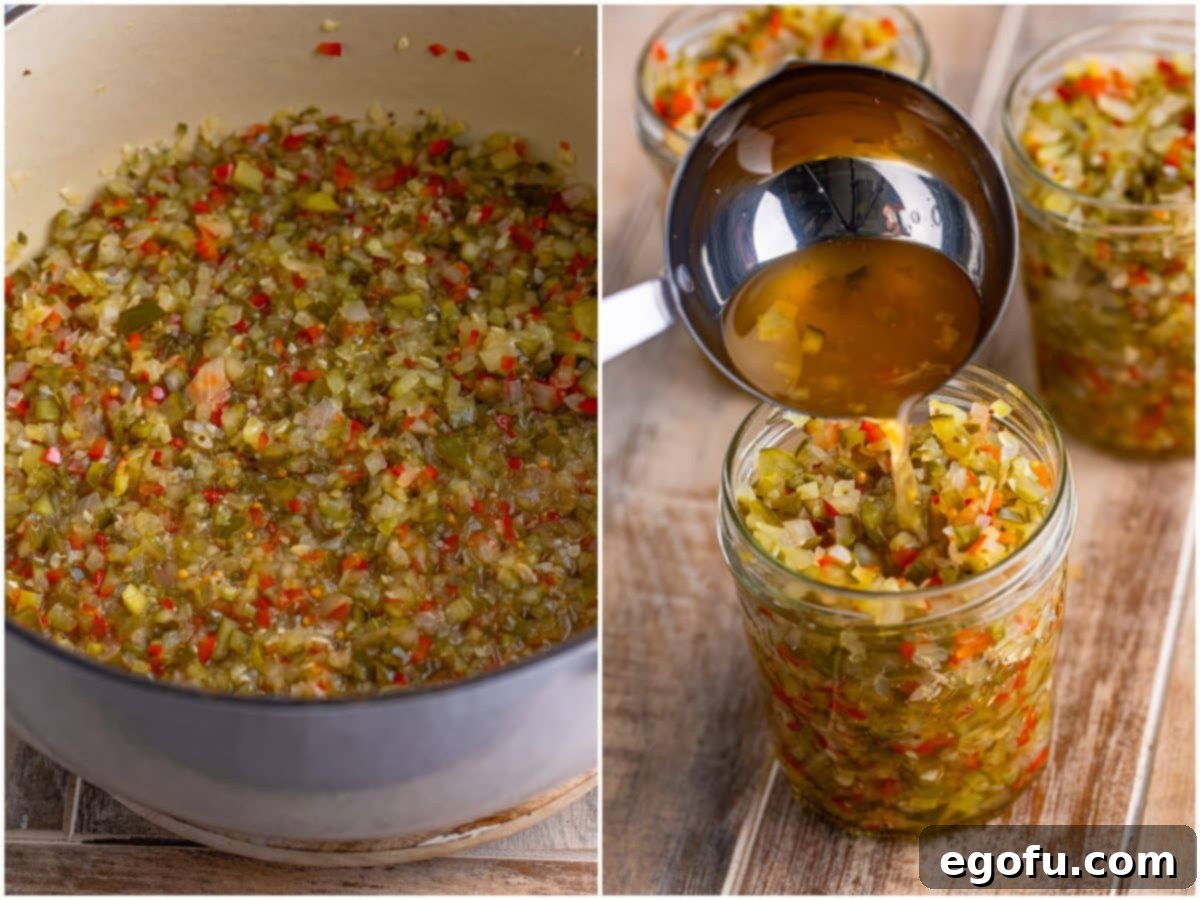
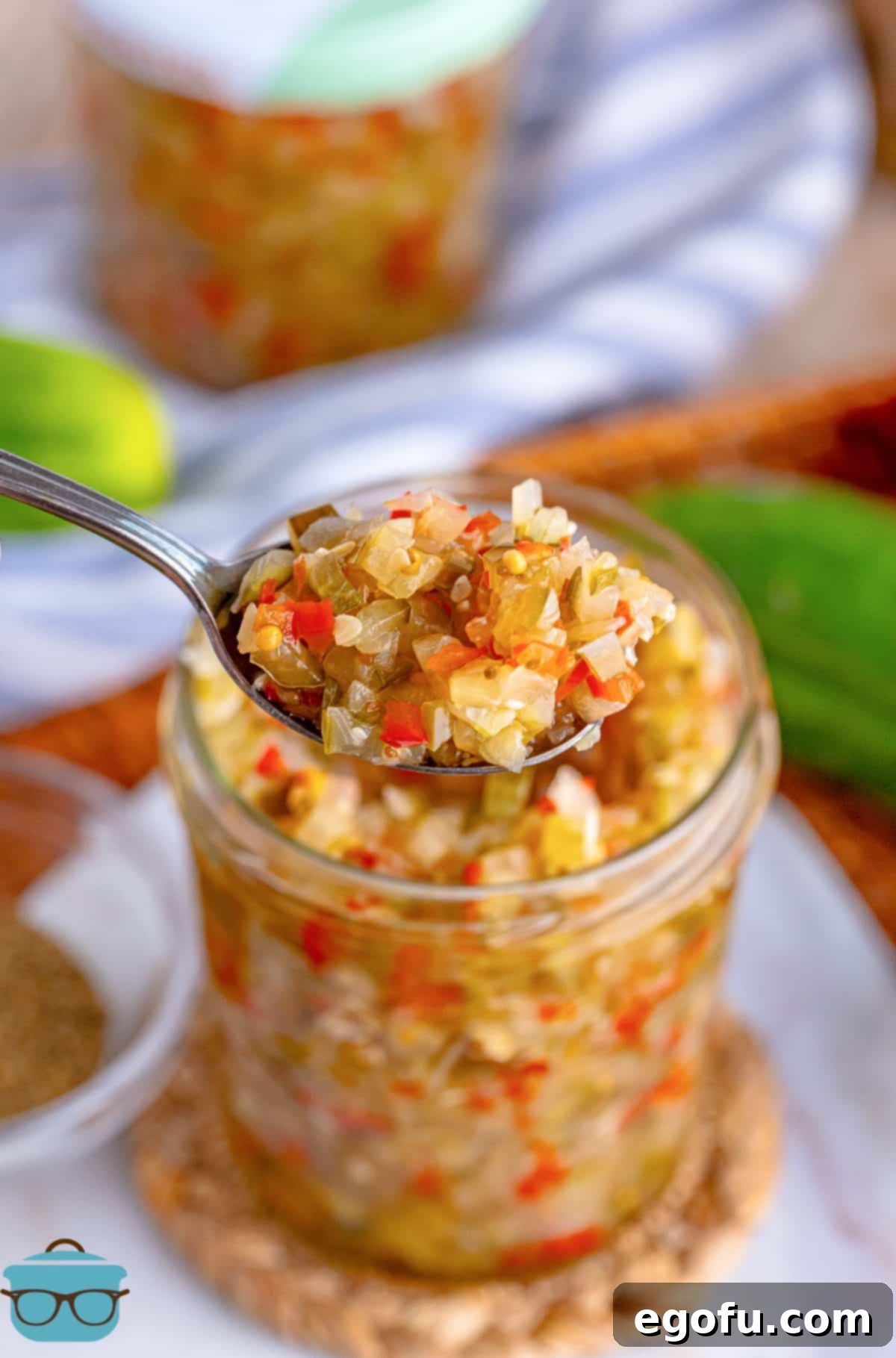
Frequently Asked Questions About Sweet Pickle Relish
Is relish just chopped up pickles?
While pickles are an essential component, relish is much more than just chopped pickles. As you can see from our ingredient list and process, this recipe incorporates a medley of fresh vegetables like red bell pepper and white onion, along with apple cider vinegar and a carefully selected blend of spices (celery and mustard seeds). These additional ingredients contribute layers of flavor, aroma, and texture that transform simple chopped cucumbers into a complex, tangy-sweet condiment, distinct from plain pickles.
What is the difference between sweet pickles and sweet relish?
Both sweet pickles and sweet relish begin with cucumbers preserved in a sweet brine, but their forms and uses differ significantly. Sweet pickles are typically whole or sliced cucumbers that retain their original shape, submerged in a sweet, vinegary solution often flavored with sugar and spices. They are primarily enjoyed as a snack, a side dish, or an accompaniment to sandwiches. Sweet relish, on the other hand, is made from finely chopped cucumbers combined with other finely diced vegetables (like bell peppers and onions) and then pickled in a similar sweet brine with additional spices. The fine chop and the vegetable medley give relish a spreadable, condiment-like consistency, making it ideal for topping hot dogs, mixing into salads, or enhancing dressings and spreads.
Should I peel the cucumbers when making Sweet Pickle Relish?
The decision to peel your cucumbers largely depends on the type of cucumber you’re using and your personal preference. For cucumbers with thick, waxy, or potentially bitter skins, such as standard garden cucumbers, peeling is generally recommended to ensure a tender relish. However, thinner-skinned varieties like English (or “seedless”) cucumbers or pickling cucumbers typically do not need to be peeled, as their skins are delicate and edible, adding to the relish’s texture. Ultimately, if you prefer a smoother relish or dislike any hint of cucumber skin, feel free to peel regardless of the variety. It’s about achieving the texture you enjoy most.
How long do I have to wait for it to chill?
While you can technically sample the relish once it’s cooled, we highly recommend allowing it to chill in the refrigerator overnight, ideally for at least 8 hours. This extended chilling period is crucial for the flavors to fully develop and meld together. Just like a good stew or sauce, the ingredients need time to harmonize and deepen their complex notes within the brine. Serving it very cold also enhances its refreshing and crisp qualities, making for a truly enjoyable experience.
Is this Sweet Pickle Relish super sweet?
No, this recipe is carefully balanced to provide a pleasant sweetness without being overpowering. The ¾ cup of granulated sugar works harmoniously with the tangy apple cider vinegar and other savory ingredients. However, if you have a pronounced sweet tooth and prefer a more intensely sweet relish, you can easily increase the sugar content. Feel free to add up to 1½ cups of granulated sugar to the brine mixture to achieve your desired level of sweetness.
What kind of cucumbers do I use?
For the best results, pickling cucumbers are ideal due to their firm flesh and thin skins. However, they can sometimes be seasonal or difficult to source. Excellent alternatives include Persian cucumbers and English cucumbers, both of which have thin skins that typically don’t require peeling. If using regular garden cucumbers, it’s advisable to peel them if their skins are thick. Additionally, if you’re using very large English or regular cucumbers that have developed large seeds, it’s recommended to scoop out the seeds before chopping, as they can make the relish watery. Regardless of the type, ensure you have approximately 2 pounds of prepared cucumbers for this recipe.
How long is Sweet Pickle Relish good for?
When stored in a sealed jar in the refrigerator, this homemade sweet pickle relish will maintain its freshness and quality for up to 2 weeks. For those interested in longer preservation, the relish can be processed for canning after step 9 in the instructions. If properly canned using a water bath method, it can last for many months in a cool, dark pantry. Always ensure proper canning techniques are followed for food safety. Otherwise, keep any leftover relish in a covered jar in the fridge.
Can I freeze this relish?
Yes, you can freeze this relish for extended storage, typically for up to 3 months. However, be aware that freezing may affect the texture of the vegetables, making them slightly softer or less crisp upon thawing. While the flavor will largely remain intact, the satisfying crunch might diminish. To freeze, ensure the relish is completely cooled, then transfer it to freezer-safe containers, leaving a little headspace for expansion. Thaw in the refrigerator before use.
How much Sweet Pickle Relish does this recipe make?
This recipe yields a generous amount of delicious homemade sweet pickle relish. You can expect to fill approximately three and a quarter 11-ounce jars. With each jar providing about 20-21 servings, the entire batch will give you around 65-68 servings in total. This makes it perfect for sharing, canning, or ensuring you have a steady supply of this versatile condiment on hand for various culinary uses.
Tips for Perfect Sweet Pickle Relish Every Time
Achieving the best possible homemade sweet pickle relish is easy with a few simple techniques:
- Consistent Fine Chop: Uniformly finely dicing your vegetables (cucumbers, onions, bell peppers) is paramount. This ensures that every bite has a balanced flavor and a pleasing texture, and that all vegetables cook evenly in the brine.
- Thorough Draining is Key: Don’t rush the draining process after salting. Squeeze out as much liquid as possible from the chopped vegetables. Excess moisture will dilute your brine, leading to a less flavorful and potentially watery relish.
- Adjust Sweetness to Taste: The provided sugar amount offers a balanced sweetness. However, if you prefer a tangier or sweeter relish, feel free to adjust the sugar content slightly. Taste the brine before adding the vegetables and make small adjustments.
- Don’t Skip the Seeds: Celery and mustard seeds are crucial for authentic relish flavor. Using whole seeds rather than powders prevents cloudiness and contributes to the classic taste profile.
- The Power of the Chill: The overnight chilling period is non-negotiable for optimal flavor development. Just like a good stew, relish benefits immensely from time for the ingredients to marry and deepen in taste.
- Sterilize Your Jars: While this recipe is for refrigerator relish, sterilizing your jars before filling is always a good practice to ensure freshness and prevent spoilage, especially if you plan on extended refrigeration.
Storage and Shelf Life for Your Homemade Relish
Proper storage is essential to enjoy your delicious homemade sweet pickle relish for as long as possible. Once the relish has cooled and thoroughly chilled overnight, it should be kept in airtight jars in the refrigerator. Under these conditions, it will remain fresh and flavorful for up to 2 weeks. For those interested in longer-term storage, this relish recipe is suitable for water bath canning. If you choose to can it, follow established safe canning practices for relish, which typically involves processing hot jars in a boiling water bath for a specific duration. Properly canned relish can last for up to a year in a cool, dark pantry. While freezing is an option for up to 3 months, be mindful that the texture might soften slightly upon thawing.
Ready for More? Explore Other Homemade Condiments
If you’ve enjoyed the rewarding experience of making your own sweet pickle relish, you might be inspired to try other homemade condiments and pickled delights. Expanding your pantry with these scratch-made staples brings fresh flavors and wholesome ingredients to your table. Consider these delightful recipes:
- Chow Chow Relish
- Homemade Sauerkraut
- Refrigerator Pickles
- Quick Sauerkraut
- Pickled Red Onions
- Easy Pickled Banana Peppers
- Bread and Butter Pickles
Sweet Pickle Relish Recipe Card
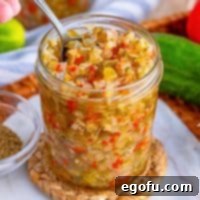
Sweet Pickle Relish
Flavorful, tangy, and sweet pickle relish to use on your hot dogs, chili dogs, sandwiches, and more.
Prep Time: 45 minutes
Cook Time: 15 minutes
Wait Time: 8 hours
Servings: 68 servings
Author: Brandie Skibinski
Ingredients
- 2 pounds pickling cucumbers, finely chopped
- 1 cup finely chopped white onion
- 1 cup finely chopped red bell pepper
- 2 Tablespoons pickling salt
- 2 quarts cold water
- 1 cup apple cider vinegar
- ¾ cup granulated sugar
- 1 teaspoon celery seeds
- 1 teaspoon mustard seeds
Instructions
- Add 2 pounds finely chopped pickling cucumbers, 1 cup finely chopped white onion, and 1 cup finely chopped red bell pepper to a large bowl.
- Sprinkle with 2 Tablespoons pickling salt.
- Add enough cold water (about 2 quarts) to submerge the vegetables. Allow to sit for 1 hour at room temperature.
- Drain very well using a fine mesh sieve or a colander lined with cheesecloth.
- Take a spoon and gently press down on the vegetables until most of the liquid drains off, then set aside.
- Add 1 cup apple cider vinegar, ¾ cup granulated sugar, 1 teaspoon celery seeds, and 1 teaspoon mustard seeds to a large pot or Dutch oven over medium heat. Stir constantly until the sugar is dissolved, then bring to a boil.
- Add the drained vegetables and stir them into the mixture.
- Bring back to a boil, stirring often, and boil for 10 minutes.
- Remove from heat and add the vegetables to jars using a slotted spoon. Pour the remaining liquid on top.
- Allow the jars to sit at room temperature until completely cooled, then add the lids and place in the fridge overnight for flavors to blend. Serve immediately.
Notes
- Please refer to the Frequently Asked Questions and ingredient list above for other substitutions or answers to common questions.
- Finely chopping the vegetables is essential for the best texture and flavor.
Course: Side Dish
Cuisine: American
Nutrition
Calories: 13kcal | Carbohydrates: 3g | Protein: 0.2g | Fat: 0.1g | Sodium: 2mg | Fiber: 0.2g | Sugar: 3g
Nutritional Disclaimer
“The Country Cook” is not a dietician or nutritionist, and any nutritional information shared is an estimate. If calorie count and other nutritional values are important to you, we recommend running the ingredients through whichever online nutritional calculator you prefer. Calories and other nutritional values can vary quite a bit depending on which brands were used.
